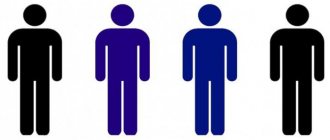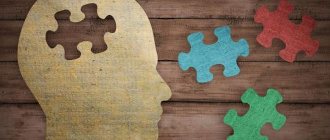Social mobility is a situation in which a person or group of people changes social status. In this case, a person can change his social stratum or remain in the same stratum and only his status will change.
Social status (or social position) is the position in society, in society, that a person (individual) or group of individuals occupies.
Social stratum is the division of people into classes or groups. The process of dividing society into layers or strata (Latin stratum - layer, layer) is called social stratification.
About social status
The social status of an individual is not only a person’s place in the system of social relations, but also the rights and responsibilities dictated by his position. Thus, the status of a doctor gives the right to diagnose and treat patients, but at the same time obliges the doctor to observe labor discipline and conscientiously perform his work.
The concept of social status was first proposed by the American anthropologist R. Linton. The scientist made a great contribution to the study of the problems of personality and its interaction with other members of society.
Statuses exist in an enterprise, in a family, in a political party, in a kindergarten, in a school, in a university, in a word, wherever an organized group of people is engaged in socially significant activities and members of the group have certain relationships with each other.
A person is in several statuses at the same time. For example, a middle-aged man acts as a son, father, husband, engineer at a factory, member of a sports club, holder of an academic degree, author of scientific publications, patient in a clinic, etc. The number of statuses depends on the connections and relationships into which the individual enters.
Types of social status
There are several classifications of statuses:
- Personal and social. A person occupies a personal status in a family or other small group in accordance with the assessment of his personal qualities. Social status (examples: teacher, worker, manager) is determined by the actions performed by the individual for society.
- Main and episodic. Primary status is associated with the main functions in a person's life. Most often, the main statuses are family man and worker. Episodic are associated with a moment in time during which a citizen performs certain actions: a pedestrian, a reader in a library, a course student, a theater viewer, etc.
- Prescribed, achieved and mixed. The prescribed status does not depend on the desires and capabilities of the individual, as it is given at birth (nationality, place of birth, class). What is achieved is acquired as a result of the efforts made (level of education, profession, achievements in science, art, sports). Mixed combines the features of the prescribed and achieved statuses (a person who has received a disability).
- Socio-economic status is determined by the amount of income received and the position that an individual occupies in accordance with his well-being.
The set of all available statuses is called a status set.
Criteria determining social status
The position in society is formed according to various criteria. The central indicator is how a person identifies himself and how other people identify him.
The set of criteria includes:
- availability of property;
- ethnic origin;
- the quality of education;
- income scale;
- life style;
- habits;
- role in the political hierarchy;
- Family status;
- speciality;
- Place of Birth.
Hierarchy
Society constantly evaluates the significance of this or that status and, on the basis of this, builds a hierarchy of positions.
Assessments depend on the benefits of the business in which a person is engaged, and on the system of values accepted in the culture. Prestigious social status (examples: businessman, director) is highly appreciated. At the top of the hierarchy is the general status, which determines not only a person’s life, but also the position of people close to him (president, patriarch, academician).
If some statuses are unreasonably low, while others, on the contrary, are excessively high, then they speak of a violation of status balance. The trend towards its loss threatens the normal functioning of society.
The hierarchy of statuses can also be subjective. A person himself determines what is more important to him, in what status he feels better, what benefits he derives from being in one position or another.
Examples from life
People have different statuses - this is easy to illustrate with simple examples.
Example 1
When a child is born, he acquires a nationality, citizenship, and is assigned the permanent status of son, daughter, girl, boy. In the school class he acquires the position of a student, in the university - a student. Having received a profession, he becomes a scientist, lawyer, economist, builder. The number of positions achieved is constantly increasing. By using political resources, willpower, and experience, a person can rise to the top of the social ladder or, conversely, slide down, reducing the level of acquired status.
Example 2
A person's position determines his status set. For example, a man of Russian nationality, forty years old, working as a teacher at a university, has a wife, mother and son. In addition, he is an Orthodox Christian and a member of the editorial board. Every day he enters into various relationships, performs duties and defends the rights that preserve his position.
The attitude towards him is based on how he plays his social role and is reflected in the characteristics:
- good parent;
- excellent family man;
- devoted friend;
- loving son;
- strict teacher.
The prestige and authority of a person depends on these indicators, but the main status—position—is most often decisive for determining one’s place in society.
Change in social status
Social status cannot be something unchanging, since people's lives are not static. The movement of a person from one social group to another is called social mobility, which is divided into vertical and horizontal.
Vertical mobility is spoken of when an individual’s social status increases or decreases (a worker becomes an engineer, a department head becomes an ordinary employee, etc.). With horizontal mobility, a person maintains his position, but changes his profession (to one of equal status), place of residence (becomes an emigrant).
Intergenerational and intragenerational mobility are also distinguished. The first determines how much children have increased or decreased their status in relation to the status of their parents, and the second determines how successful the social career of representatives of one generation is (types of social status are taken into account).
The channels of social mobility are social institutions: school, family, church, army, public organizations and political parties. Education is a social elevator that helps a person achieve the desired status.
A high social status acquired by an individual or a decrease in it indicates individual mobility. If the status of a certain community of people changes (for example, as a result of a revolution), then group mobility takes place.
What influences social mobility?
Among the factors that influence social mobility, that is, the number of movements between social strata or the frequency of changes in social status, the following main ones can be identified:
- economic;
- historical;
- demographic;
- migration;
- location;
- nationality;
- the level of education;
- abilities and personal qualities of the individual (physical and mental).
Economic factor
The economic situation in the country directly affects the availability of jobs and professions in demand. If the economy requires, for example, highly qualified specialists, this will lead to people striving to fill vacant positions. Social mobility will become more active.
Historical factor
Historical events, such as wars and revolutions, have a direct impact on mobility. At such times, some people quickly climbed the social ladder, gaining great power or great wealth. That is, political and economic mobility occurred. Others lost their status. The most well-born nobles were deprived of their savings and privileges.
Mobility also depends on the type of society that has historically been present in a particular country. There are three types of society: closed, open and intermediate.
In a closed society, as a rule, status is assigned to a person at birth and changing it is extremely difficult or impossible. In the open, people actively move between social strata and change their status throughout their lives.
An example of an intermediate type is a feudal society, in which movements between classes or estates were not officially permitted, but they still occurred.
Demographic factor
Population growth affects social mobility. If a country experiences population growth, mobility also increases. Since young people are more willing to change their social class or status.
Adults are more likely to be economically mobile. Having accumulated money, they strive to change their living conditions for the better: move to a better area (geographical mobility) or take a high position (professional mobility).
It is a fact that the lower classes have higher birth rates. If there is a shortage of people in the upper strata, their places are taken by people who have climbed the social ladder, and not by those born into this class.
Migration
Countries with high migration rates tend to have active social mobility. Migrants create competition for local residents. Cheap labor creates a surplus of workers, forcing local residents to create a competitive advantage and move up the social ladder.
Location
In cities there are more opportunities to advance your career and change your financial situation. Young people tend to move to big cities in search of such opportunities. In this case, we can also talk about intergenerational mobility, when children achieve a higher status compared to the status of their parents.
Nationality
Even in a multinational state, preference is given to the nation whose numbers prevail in this state. People of this nationality more often occupy high positions and are promoted.
The level of education
The level of education can be a competitive advantage, regardless of the stratum in which a person was born. People with higher levels of education have a better chance of advancement. At the same time, they can also create competition for people from the upper strata who have not paid enough attention to their education, relying on their privileges or connections to get a job, position, or title.
The same is true in relation to the abilities of a person inherent from birth, or the personal qualities that he has developed in himself.
Social roles
While in one status or another, a person performs actions, communicates with other people, that is, plays a role. Social status and social role are closely interrelated, but differ from each other. Status is a position, and a role is socially expected behavior determined by status. If a doctor is rude and swears, and a teacher abuses alcohol, then this does not correspond to the status he holds.
The term “role” was borrowed from theater to emphasize the stereotypical behavior of people of similar social groups. A person cannot do as he wants. The behavior of an individual is determined by the rules and norms characteristic of a particular social group and society as a whole.
Unlike status, a role is dynamic and closely related to a person’s character traits and moral attitudes. Sometimes role behavior is adhered to only in public, as if putting on a mask. But it also happens that the mask fuses with its wearer, and the person ceases to distinguish between himself and his role. Depending on the situation, this state of affairs has both positive and negative consequences.
Social status and social role are two sides of the same coin.
Status incompatibility
If the statuses that a person possesses contradict each other and introduce disharmony, incompatibility arises.
The process develops for 2 reasons:
- when a person occupies a high level in the first social group and a low level in another;
- if the rights and obligations in one position interfere with compliance with the rules established by the second status.
Incompatibility causes tension and dissatisfaction. Disharmony provokes disappointment in life.
Example of incompatibility
A native of the nineties, he made a good fortune and is now the owner of a large company. But he does not have a university education, and this is reflected in his lack of specific knowledge. A person has a high role as an entrepreneur, a rich person, and at the same time there is a low status of culture and education.
Professional athletes can also be cited as an example. They have authority and material well-being, but lack social power.
Diversity of social roles
Since there are many people in the world and each person is an individual, it is unlikely that there will be two identical roles. Some role models require emotional restraint and self-control (lawyer, surgeon, funeral director), while for other roles (actor, teacher, mother, grandmother) emotions are very much in demand.
Some roles drive a person into strict frameworks (job descriptions, regulations, etc.), others have no framework (parents are fully responsible for the behavior of their children).
The performance of roles is closely related to motives, which are also different. Everything is determined by social status in society and personal motives. An official is concerned with promotion, a financier is concerned with profit, and a scientist is concerned with the search for truth.
↑ Marginality and marginalized people
One of the distinguishing characteristics of modern society is marginalization.
Marginalization
is a process during which certain individuals or groups are pushed to the periphery of society, and sometimes excluded from it. Socially weak and unprotected layers and groups of the population are at risk of marginalization - the disabled, the unemployed, the poor, the homeless, whose poverty forces them
adhere to a lifestyle that differs from that prevailing in a given society.
Marginalized
- these are people who occupy an intermediate position between stable communities, who have lost stable social ties. In order to prevent marginalization as a painful and dangerous phenomenon, Russia has a comprehensive system of measures (social shelters, funds to help the poor, rehabilitation centers, etc.).
Role set
A role set is understood as a set of roles characteristic of a particular status. Thus, a doctor of science is in the role of a researcher, teacher, mentor, supervisor, consultant, etc. Each role implies its own ways of communicating with others. The same teacher behaves differently with colleagues, students, and the rector of the university.
The concept of “role set” describes the whole variety of social roles inherent in a particular status. No role is strictly assigned to its bearer. For example, one of the spouses remains unemployed and for some time (and perhaps forever) loses the roles of colleague, subordinate, manager, and becomes a housewife (householder).
In many families, social roles are symmetrical: both husband and wife equally act as breadwinners, masters of the house and educators of children. In such a situation, it is important to adhere to the golden mean: excessive passion for one role (company director, businesswoman) leads to a lack of energy and time for others (father, mother).
Role Expectations
The difference between social roles and mental states and personality traits is that roles represent a certain historically developed standard of behavior. There are requirements for the bearer of a particular role. Thus, a child must certainly be obedient, a schoolboy or student must study well, a worker must observe labor discipline, etc. Social status and social role oblige one to act one way and not another. The system of requirements is also called expectations.
Role expectations act as an intermediate link between status and role. Only behavior that corresponds to status is considered role-playing. If a teacher, instead of giving a lecture on higher mathematics, starts singing with a guitar, then students will be surprised, because they expect other behavioral reactions from an assistant professor or professor.
Role expectations consist of actions and qualities. Taking care of the child, playing with him, putting the baby to bed, the mother performs actions, and kindness, responsiveness, empathy, and moderate severity contribute to the successful implementation of actions.
Compliance with the role being performed is important not only to others, but also to the person himself. A subordinate strives to earn the respect of his superior and receives moral satisfaction from a high assessment of the results of his work. The athlete trains hard to set a record. The writer is working on a bestseller. A person’s social status obliges him to be at his best. If an individual's expectations do not meet the expectations of others, then internal and external conflicts arise.
Role conflict
Contradictions between role holders arise either due to inconsistency with expectations, or due to the fact that one role completely excludes another. The young man more or less successfully plays the roles of son and friend. But the guy's friends invite him to a disco, and his parents demand that he stay at home. The emergency doctor's child falls ill, and the doctor is urgently called to the hospital because a natural disaster has occurred. The husband wants to go to the dacha to help his parents, and the wife books a trip to the sea to improve the health of the children.
Resolving role conflicts is not an easy task. Participants in the confrontation have to decide which role is more important, but in most cases compromises are more appropriate. The teenager returns from the party early, the doctor leaves his child with his mother, grandmother or nanny, and the spouses negotiate the timing of participation in dacha work and travel time for the whole family.
Sometimes the solution to the conflict is leaving the role: changing jobs, going to university, getting a divorce. Most often, a person understands that he has outgrown this or that role or that it has become a burden to him. A change of roles is inevitable as the child grows and develops: infant, toddler, preschooler, primary school student, teenager, young man, adult. The transition to a new age level is ensured by internal and external contradictions.
Socialization
From birth, a person learns the norms, patterns of behavior and cultural values characteristic of a particular society. This is how socialization occurs and the individual’s social status is acquired. Without socialization, a person cannot become a full-fledged individual. Socialization is influenced by the media, cultural traditions of the people, social institutions (family, school, work collectives, public associations, etc.).
Purposeful socialization occurs as a result of training and upbringing, but the efforts of parents and teachers are adjusted by the street, the economic and political situation in the country, television, the Internet and other factors.
The further development of society depends on the effectiveness of socialization. Children grow up and occupy the status of their parents, taking on certain roles. If the family and the state do not pay enough attention to the upbringing of the younger generation, then degradation and stagnation occur in public life.
Members of society coordinate their behavior with certain standards. These may be prescribed norms (laws, regulations, rules) or unspoken expectations. Any non-compliance with standards is considered a deviation, or deviation. Examples of deviation are drug addiction, prostitution, alcoholism, pedophilia, etc. Deviation can be individual, when one person deviates from the norm, and group (informal groups).
Socialization occurs as a result of two interrelated processes: internalization and social adaptation. A person adapts to social conditions, masters the rules of the game, which are mandatory for all members of society. Over time, norms, values, attitudes, ideas about what is good and what is bad become part of the inner world of the individual.
People are socialized throughout their lives, and at each age stage, statuses are acquired and lost, new roles are learned, conflicts arise and are resolved. This is how personality development occurs.










